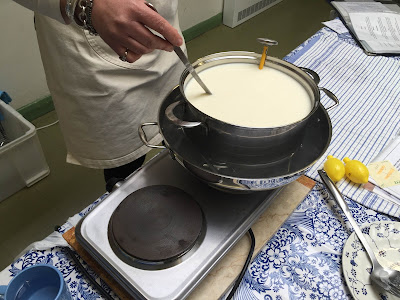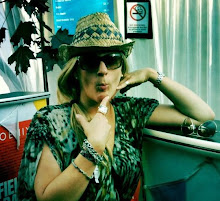Wow. I'm already more than a quarter of the way into my blog and this is the first participatory food-related week. I am shocked. There will be more. In fact, bread-making is coming up in May. That was not good planning. The two workshops would have merged and slotted in so perfectly next to one another. Mmmm, I'm just thinking about bread and cheese; some crusty French bread and ripe camembert would be my choice, perhaps with some pomodoro tomatoes and cucumber slices. A lunch of Kings as far as I'm concerned.
Anyway, I digress. Learning to make cheese. I'm not entirely sure what images I had in my head before going to a cheese-making workshop. I think I imagined a group of people in some sort of farm house working on long, wooden benches or industrial kitchen with mountains of equipment. In reality, we were in a mundane church events space with nothing but this in front of us.
It all looked a little clinical and scientific to me but I guess that the process of making cheese is all about science. Essentially, cheese is made from souring milk through the addition of an acid or from a bacterial culture. Its fermentation and probably a similar process to how bread and wine are made. But, for me, this fermentation process seems somewhat gross. I mean, you're turning something fresh and cold and lovely into something sour and curdled. But, then again I love cheese so get over it.
The workshop was designed and led by the very lovely Louise Talbot of
Cutting the Curd who informed us that we would be learning to make halloumi, mozzarella, mascarpone and butter, all in the 3.5 hour workshop.
She did a very good job of talking us through the process of how cheese is made. First off, you need very good milk. Whole milk is going to be better than skimmed because it is creamier and has more fat in it, therefore will yield a creamier cheese. The milk has to be only just pasteurised and not processed several times. Then you need to add some sort of bacterial culture or an enzyme such as rennet to separate the milk into curds and whey. It does this by destabilising the proteins in the milk and causes clots which form the curds and expels the whey. Most cheese is made from the curds, although interestingly, whey is actually worth more.
We started off with the halloumi and watched as Louise prepared everything. She started off by adding calcium chloride to the milk. This restores the proteins in the milk that have been damaged by pasteurisation.
Then Louise got the milk on the heat and was very careful to keep an eye on the temperature - this is one of the things that really determines how good your curds and whey are going to be. Afterwards, she added the rennet and then left the pan of milk to sour for half an hour, while we moved on to the preparation of the mozzarella. This was a very similar process but involved using less rennet and more of an acid to sour the milk.
After about 40 minutes we came back to the concoction that was to end up as halloumi and the clotting process had indeed happened. The milk had soured, clotted and what emerged was a very firm structure, a bit Blancmange-like.
We then had to cut the curd in order to release the whey and allow it to drain. You have to cut the curds into small, uniform size pieces in order to increase the surface area and allow the whey to continue draining. This will help get a better yield. But, as Louise pointed out, there is a tender art to making cheese, everything has to be done very carefully and gently. So even though you are cutting the curds you have to be careful not to break them up.

After letting the curds sit for a few minutes, you then have to totally separate them from the whey by spooning them into a mould and letting the whey collect. Once thats done you keep the curds wrapped in a cheese cloth and leave them for a couple of hours to set.
We then returned to the mozzarella and went through the same process of cutting, separating, pouring and draining.
After Louise made some mascarpone, we all had a tea break and did a little "name the cheese" test. I came joint top guessing eight out of the twelve cheeses correctly. I should have got Emmental, darn it.
It was then time to make some butter; a super easy process of whizzing up cream in a food processor until it comes together in a clump and turns yellow. You do then have to sieve it and press out all the butter milk though otherwise the butter will turn rancid.
After all the fiddling and faffing we were in the home straight now with the two main cheeses. We returned to the mozzarella to do the stretching. This was done by re-heating the curd (to about 70 degrees) and then taking a portion of it at a time and moulding it to make it pliable and stretchy. We did this by folding it a few times and shaping it until it was smooth and elastic. Then we formed each portion into a ball and placed it in some salted chilled water.
Finally, we finished off the halloumi. After leaving it for a good couple of hours it had set into a block. Louise got the reserved whey heated up and after slicing up the curd, placed each piece into the boiling liquid. Each piece then had time to set and get a little salting.



Each of us got to take home a few slices of the halloumi, a mozzarella ball and a small pot of mascarpone and the butter. Pretty cool really to think that all of them started off life as some whole milk or double cream just a few hours before. I would have liked to have actively done more during the day - unfortunately you do have to be shown what to do so it was mostly Louise doing it all and us watching, or us doing a bit of "sous-cheffing" but, nevertheless it was utterly fascinating. But, I'm in no rush to start doing it as a regular activity - yes its easy and probably pretty cheap to do once you've bought all the utensils, but I'm not one for massive amounts of faffing unnecessarily. Some would probably argue otherwise!






























1 Comment:
amazing!!!!
Post a Comment